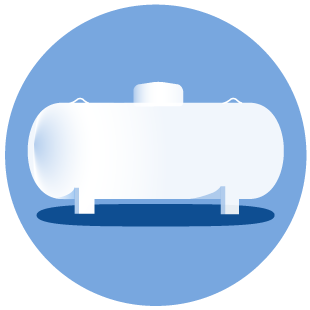Field Guide for the Assessment and Cleanup of Soil and Groundwater Contaminated with Condensate From a Spill Incident
Statewide Rules 8, 20 and 91
Introduction
This Field Guide will help the District Offices and responsible parties clean up condensate spills in a manner that assures the goals established by Statewide Rules 8, 20, and 91 are met.
Statewide Rule 8 provides that no person conducting activities subject to regulation by the Railroad Commission of Texas may cause or allow pollution of surface or subsurface water in the state. Rule 20 provides that operators shall give immediate notice of a fire, leak, spill or break, followed by a letter giving the full description of the event including the volume of products lost. Rule 91 provides that cleanup requirements for hydrocarbon condensate spills and crude oil spills in sensitive areas will be determined on a case-by-case basis.
Statewide Rule 91 distinguishes two categories of spills: (a) crude oil spills into non- sensitive areas; and, (b) (i) hydrocarbon condensate spills; and (ii) crude oil spills in sensitive areas. Rule 91 establishes clear goals for cleanup of crude oil spills in non-sensitive areas: immediate removal of all free oil; immediate vertical and horizontal delineation; specifying the "area of contamination" that must be delineated and disposed of or remediated and specification of a final cleanup level of "1.0% by weight total petroleum hydrocarbon." Rule 91 is less clear about the second category of spills.
It stands to reason that hydrocarbon condensate spills and crude oil spills in sensitive areas, which pose greater risks, should at least follow standards established for the equally important but less threatening spills. Over time, the Commission has come to believe the lack of enumerated standards for condensate spills hamstrings field personnel and perpetuates unacceptable risk to the water and subsurface water of the state. Commission staff, therefore, implements the following field guide to establish bench marks and protocols that, when met and followed, will demonstrate that condensate spills have been addressed in a manner that complies with Statewide Rules 8, 20 and 91.
This Guide provides notice of criteria field personnel may employ in judging whether a hydrocarbon condensate spill response is adequate or inadequate. This guidance is intended to make operators and responsible persons aware of the Commission's position and afford an opportunity for voluntary compliance.
The sampling described in this guide is specific to delineation sampling. In addition to the samples obtained for delineation, an appropriate number of samples should also be obtained and analyzed to characterize the impacted area.
Approved Criteria
It is recommended that field personnel use the following criteria to evaluate compliance with Statewide Rules 8, 20 and 91 after a condensate release. The operator/responsible person response actions should include the following activities:| Notification | Delineation | Remediation | Protection of Subsurface Water | Confirmed Groundwater Impacts | Documentation of Condensate Releases |
A. Notification:
- Provide notice of the release to the Commission. (Note: condensate spills exceeding five barrels shall be immediately reported to the Commission. All spills of condensate into water must be immediately reported to the Commission).
- Remove all free liquids immediately.
B. Delineation:
- Horizontal and vertical delineation of all reportable condensate spills is required.
- Grab samples (not composite samples) are to be collected and analyzed at a laboratory for Total Petroleum Hydrocarbons (TPH) and benzene, toluene, ethyl benzene and xylenes (BTEX) to verify that delineation has been achieved. (Note: Knowledge about product composition is helpful in determining appropriate analytical methods. TPH analyses should use standard industry methods, which include, but are not limited to 418.1, modified TNRCC 1005 (to include carbon fractions up to C-35), TNRCC 1006, or Massachusetts VPH/EPH. BTEX analyses should be conducted using EPA-approved methods, which include 8260 or 8021B. Any of these methods or any additional method may be used provided that the operator/responsible party demonstrates that the method is appropriate to characterize the specific condensate).
- Soil delineation is to be conducted to soil to groundwater protection limits illustrated in the appropriate table of section C of this guidance.
- All condensates spills of any volume are to be remediated.
- If reportable releases are immediately excavated and properly disposed of the operator/responsible person may limit grab samples and laboratory analytical results to one confirmation sample of TPH and BTEX at the base of the excavation where deepest spill penetration has occurred.
- When reportable releases are not immediately excavated, the operator/responsible person shall collect multiple grab samples (not composite samples) and analyze for TPH and BTEX to provide adequate soil delineation that determines the lateral and vertical extent of impact.
- Soil remediation is to be conducted to soil to groundwater protection limits illustrated in the appropriate table of section C of this guidance.
- If soil concentrations are above the soil to groundwater protection limits an evaluation should be performed to determine if a Risk Assessment is the appropriate remedial option.
- If on-site bioremediation is chosen to meet Commission compliance goals, soil mixing with ambient or clean soil must achieve a uniform mixture that is no more than 18 inches in depth and contains no more than 5.0% by weight TPH. In the absence of a Risk assessment, closure of the land-farm will require that soil to groundwater protection limits are achieved for all compounds of concern.
D. Protection of subsurface water (groundwater):
When data indicate that subsurface water may be impacted, soil and groundwater delineation should be based on site-specific criteria that will protect the potentially impacted groundwater resource. The operator/responsible person should conduct the following activities:- Collect sufficient information and data to determine the classification of the first groundwater zone as Class 1, Class 2, or Class 3. (Note: see Attachment A of this document for groundwater classification definitions.)
- For delineation of Class 3 groundwater zones a minimum of 5 soil sample locations (to delineate the lateral and vertical extent) shall be analyzed for TPH and BTEX. Lateral and vertical soil delineation should be conducted to the following soil-to-groundwater protection limits:
|
Compound
|
Residential Limits
(mg/kg) |
Industrial Limits
(mg/kg) |
|
TPH
|
10,000
|
10,000
|
|
Benzene
|
2.6
|
2.6
|
|
Toluene
|
820
|
820
|
|
Ethylbenzene
|
760
|
760
|
|
Xylenes
|
12000
|
12000
|
For delineation of Class 1 or Class 2 groundwater zones, a minimum of 5 soil sample locations (to delineate the lateral and vertical extent) shall be analyzed for TPH and BTEX. Special consideration should be given by the Commission to determine whether there is a need for a groundwater investigation, and if so, whether the operator/responsible person installed monitor well(s) and conducted groundwater sampling. Lateral and vertical soil delineation should be conducted to the following soil-to-groundwater protection limits:
Table 2: Class 1 and Class 2 Soil-to-Groundwater Protection Limits for Delineation and Remediation
|
Compound
|
Residential Limits (mg/kg)
|
Industrial Limits (mg/kg)
|
|---|---|---|
|
TPH
|
10,000
|
10,000
|
|
Benzene
|
0.026
|
0.026
|
|
Toluene
|
8.2
|
8.2
|
|
Ethylbenzene
|
7.6
|
7.6
|
|
Xylenes
|
120
|
120
|
E. Confirmed groundwater impacts
- Where impacts to Class1 and 2 groundwater have been confirmed, the operator/responsible person should use permanent monitor wells to delineate groundwater impacts to the following limits:
|
Compound
|
Maximum Contaminant Level |
|---|---|
|
TPH
|
1.1*
|
|
Benzene
|
0.005
|
|
Toluene
|
1.0
|
|
Ethylbenzene
|
0.7
|
|
Xylenes
|
10.0
|
*Not a maximum contaminant level
- Where impact to Class 3 groundwater resources have been confirmed, the operator/responsible person is to delineate to limits that are 100 times the Class 1 and 2 limits listed above.
F. Documentation of condensate releases
The operator/responsible person should provide the following documentation regarding condensate releases:- A summary of the events related to the immediate or emergency activities that took place following discovery of the release, including the total volume of condensate released and recovered.
- A description of the released condensate, including the API gravity (if available) and any additional condensate properties. Gas chromatographs may be useful for this purpose.
- A topographic map showing the release location and the proximity of all domestic and irrigation water supply wells within a ½ mile radius of the delineated edge of the release. GPS coordinates should also be provided if they are available.
In appropriate cases, consider requesting the following additional documentation:
- Analytical data in support of delineation.
- A remedial investigation report, including total volumes of impacted media recovered and disposed, soil investigation and verification results and groundwater investigation results.
- An annotated map of the free-phase and dissolved-phase of any groundwater contaminant plume.
- Subsurface soil characterization and/or geologic cross-sections, including stratigraphy and lithology of the subsurface.
ATTACHMENT A Groundwater Classification Definitions
Class 1 Groundwater Resource
- A groundwater-bearing unit which is the only reliable source of water (i.e., a connection to a public water system is not currently available) not more than 800 feet below the land surface that is capable of producing groundwater with a naturally occurring total dissolved solids content of less than 1,000 milligrams per liter (mg/l) and at a sustainable rate greater than 5,000 gallons per day to a well with a four inch diameter casing or an equivalent sustainable rate in gallons per day to a well with a smaller or larger diameter casing; or
- Groundwater-bearing unit capable of yielding groundwater with less than or equal to a naturally occurring total dissolved solids content of 3,000 mg/l and at a sustainable rate greater than or equal to 144,000 gallons per day to a well with a 12 inch diameter casing or an equivalent sustainable rate in gallons per day to a well with a smaller or larger diameter casing, and the natural quality of that groundwater meets all primary drinking water standards as defined in 40 Code of Federal Regulations Part 141, as amended.
Class 2 Groundwater Resource
- Any groundwater-bearing unit which is a groundwater production zone for an existing well located within 1/2 mile of the affected property and which is used to supply groundwater for human consumption, agricultural purposes or any purpose which could result in exposure to human or ecological receptors; or
- Any groundwater-bearing unit which is capable of producing waters with a naturally occurring total dissolved solids content of less than 10,000 mg/l and at a sustainable rate greater than 150 gallons per day to a well with a four inch diameter casing or an equivalent sustainable rate in gallons per day to a well with a smaller or larger diameter casing.
Class 3 Groundwater Resource
Any groundwater-bearing unit which produces water with a naturally occurring total dissolved solids content of greater than 10,000 mg/l or at a sustainable rate less than 150 gallons per day to a well with a four inch diameter casing or an equivalent sustainable rate in gallons per day to a well with a smaller or larger diameter casing.







